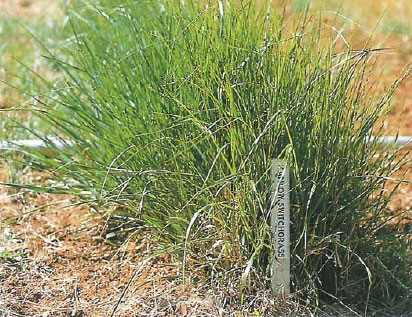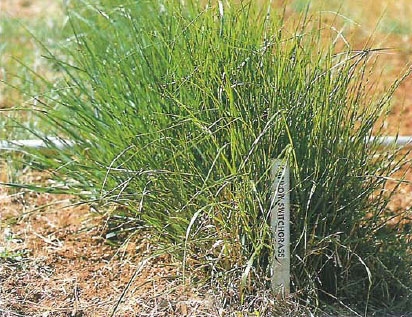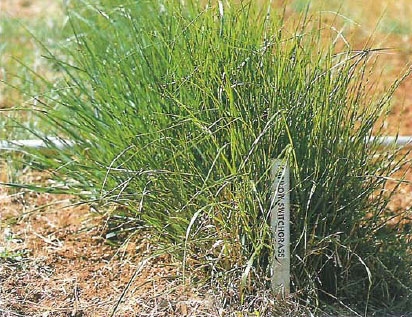
Posts Tagged: switchgrass
Green energy may generate more greenbacks for farmers
California’s role as an emerging world leader in the development of green energy technologies offers the state’s farmers the opportunity to diversify their cropping systems and increase their income.
Sacramento lawmakers have given the California Energy Commission an annual budget of $100 million to support the development of alternative and renewable low-carbon fuels. In addition, the State Alternative Fuels Plan set goals of reducing petroleum dependence by 15 percent and increasing alternative fuels use by 20 percent by 2020. These efforts are meant to help meet the growing fuel demands of the world population while reducing greenhouse gas emissions in California to 1990 levels.
“With the new mandates, there are new opportunities for using agricultural waste and dedicated energy crops for biofuels, but we’re not yet sure exactly what form it will take,” said UC Cooperative Extension alfalfa specialist Dan Putnam. “I would always encourage growers to experiment with the crop, but I wouldn’t jump in whole hog unless I had a buyer lined up.”

U.S. ethanol production in January 2010 was 818,000 barrels per day, according to the U.S. Energy Information Administration. The United States uses about 20 million barrels of oil per day. If the EPA allows up to 15 percent ethanol blends for all vehicles, then the 10 million barrels per day of oil used by cars and trucks could allow ethanol and biofuels to make up 1.5 million barrels per day.
Cellulosic biomass is the only known resource for the sustainable production of liquid transportation fuels on a large scale and at low costs, according to UC Riverside environmental engineer C. W. Wyman. Cellulosic biomass includes agricultural residues such as corn stems and leaves, forestry residues such as sawdust and paper, landscape waste, herbaceous plants such as switchgrass and sorghum, and woody plants such as poplar trees.
Since a dry ton of cellulosic biomass could provide about three times as much energy as a barrel of petroleum, the cellulosic biomass would have three times the value as a barrel of petroleum. That means cellulosic biomass would be worth about $200 per dry ton when crude oil sells at $65 per barrel.
“To utilize this abundant resource, we must develop low-cost technologies for transforming biomass into fuels that can compete with petroleum,” Wyman wrote in a California Agriculture article “Cellulosic biomass could meet California’s transportation fuel needs.”
Current and potential biomass crops include the grasses switchgrass and miscanthus, other perennial grasses, plus high biomass sorghum, alfalfa and other crops.
Across California, University of California scientists are studying potential biofuel crops. Putnam has four research trials under way, testing varieties from Ceres and Mendel Biotechnology, Inc. He said switchgrass and miscanthus the top contenders so far in his trials.
“The yields of switchgrass under irrigation have been quite high,” Putnam said. “It is an efficient crop for converting solar energy into biomass under warm weather condition.”
Switchgrass does have relatively high water needs. Putname said scientists are looking into whether the crop can be grown under deficit irrigation to save water and still produce the biomass.
“The key issue with biofuels is not necessarily the total water requirement, but the water use efficiency and amount of biomass produced per unit of water,” Putnam said. “Even if a crop has high water use, if it produces a large amount of biomass, it may still be the best option.”
Steve Kaffka and UC Cooperative Extension advisors are involved in research on winter annual oilseeds such as canola, camelina and meadowfoam as potential biofuel feedstock crops.
“Recent economic modeling we have done suggests that at current market prices, canola is a competitive crop in California, but outlets have not yet developed for the seed,” Kaffka said. “Currently, petroleum prices are too low to support the use of canola for biofuel feedstocks, but that is changing rapidly. “
The director of the UC Kearney Research and Extension Center, Jeff Dahlberg, sees opportunities for California production of sorghum as a biofuel crop.
"Sorghum is one of the few crops that span all the different renewable fuel options," he said. "You can use the grain to convert into ethanol. We have sweet sorghum, a specialty sorghum which is very similar to sugar cane. You can press the juice out and convert it into ethanol. And, we can produce a lot of biomass."
Dahlberg previously served as research director for the National Sorghum Producers and the research director for the United Sorghum Checkoff Program in Lubbock, Tex. He currently is lead investigator on a $984,000 U.S. Department of Energy grant to study the composition of sorghum and its potential for cellulosic conversion to biofuel. In addition to continuing this research at Kearney, Dahlberg is interested in developing a center for on-farm green technologies at the Central California research station.
Biomass may help solve world energy problems
UC Cooperative Extension forage specialist Dan Putnam believes California farmers need to envision and implement biomass-based, highly productive food, fuel and energy production systems to meet the increasing demands of the growing world population.
Putnam's thoughts were written up by reporter Cary Blake and posted yesterday on the Western Farm Press website.
The article noted that one biomass crop showing potential in California is switchgrass, which is grown in other parts of the country for forage. Putnam has four switchgrass trials underway.
"The switchgrass yields, especially in the Central Valley, California trials, are quite impressive on good soils with irrigation," Putnam was quoted in the story. "Yields have reached 18 tons per acre — some of the highest switchgrass yields recorded in the nation."
The fact that switchgrass may not need water year round is another favorable attribute. The plant's deep root system enables it to survive in low water conditions.
"This is very encouraging, especially in California where water supplies are an ongoing concern," Putnam said.
Putnam urged farmers to cautiously investigate biomass to determine how it may fit into their diversification portfolio.
"The next few years should be an exciting ride for U.S. agriculture in terms of new opportunities in the energy sector," Blake wrote in closing.

Switchgrass is a possible biofuel crop.
Biofuel is a growing opportunity for California
Federal law requires annual U.S. production of 36 billion gallons of biofuels by 2022, creating a potentially profitable opportunity for California farmers, according to UC experts quoted in Western Farm Press.
Writer Cary Blake based two stories in the magazine's current issue on the April 2010 Alfalfa, Forages and Biofuels Field Day at the UC Desert Research and Extension Center in El Centro.
The story said UC Davis Cooperative Extension agronomist Steve Kaffka is optimistic about the future of California biofuels production.
"Available solar energy and water make the Imperial Valley one of the prime places in the world where renewable fuels could be produced," Kaffka told the assembly of farmers, pest control advisers and industry representatives.
Additionally, potential California biofuel crops, like switchgrass and jatropha, will likely carry a smaller carbon footprint than Midwest-produced corn ethanol. Information Kaffka shared with field day participants said Midwestern corn ethanol has a higher total carbon footprint than gasoline.
The companion Western Farm Press article provided details on UC research on the biofuels crops switchgrass and jatropha.
UC Davis Cooperative Extension forage specialist Dan Putnam said switchgrass has good yield potential, but more research is needed. Sham Goyal, UC Davis agronomist, said he has never found a plant that is more drought tolerant than jatropha, which has seeds that contain 35 to 45 percent oil.
"This plant can get by on a minimum amount of water," Goyal was quoted. "This very characteristic makes this plant very suitable for the Imperial Valley."

A sample of switchgrass.
